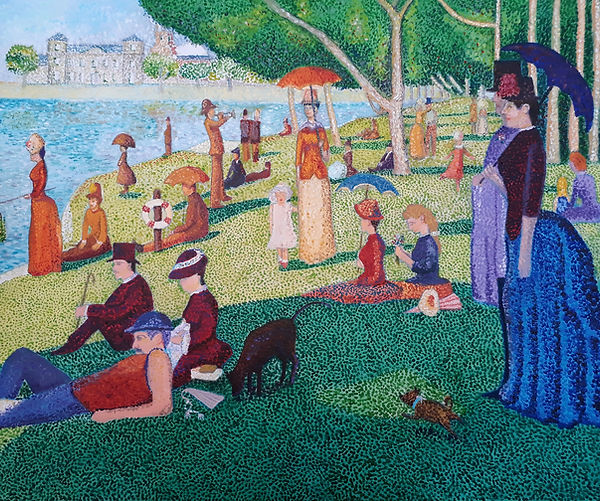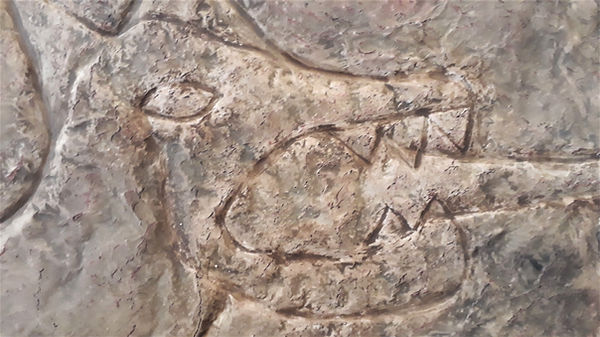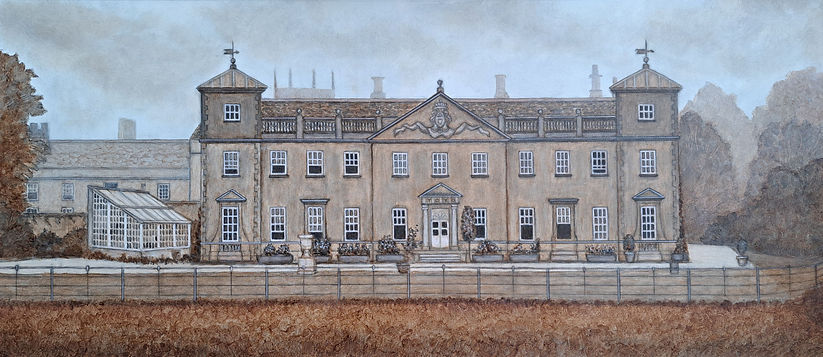
Lydiard House Series
Here are a series of paintings in the style of old masters, put together for fun, learning and to raise awareness of Lydiard House and the adjoining St Mary's church at Lydiard, Swindon.

My take on the Mona Lisa by Leonardo Da Vinci, Lydiard House and St Mary's church depicted in the background, top left. I thoroughly enjoyed painting this one as it was a first for me to take on the techniques used by Da Vinci.
An original painting by George Stubbs depicts a horse by the lake at Lydiard which contains Lydiard House in the background. That painting inspired me to look at other possible old master paintings with a view to including Lydiard House in their backgrounds, purely for fun and as an exercise for my personal learning of different art styles and techniques.
It would also serve as an awareness project for Lydiard House and St Mary's church, as funds were needed for an exciting conservation project inside the church, which has already begun.

My take on Sunday Afternoon by Georges Seurat
I must admit this one was very time consuming and I'm fairly confident I wouldn't want to take on another Seurat. Georges style is pointillism, an arrangement of coloured paint dots that once placed together take on the appearance of other colours than the ones placed, as in litho colour printing today. I did bypass the true technique on this painting though by using the colours I needed where needed. It took long enough!

My take on cubism, in the style of Picasso, Braques and Gris.
I couldn't find the right original painting to depict the house and the church so I took on the challenge of focusing solely on the two buildings and attempting to produce a cubist painting of my own in the style of the above artists.
Taking in all views at different angles and piecing them together using a minimal palette of colours, then shading from dark to light within the shapes made this a very fun exercise indeed.

Poppy Fields at Lydiard, in the style of Claude Monet.
There aren't any poppy fields outside Lydiard House but I do have a love for impressionism and as the original painting has a centralised house then this painting seemed a good choice.
As I said before, I do have a soft spot for impressionist paintings and to create a painting in that style is an enjoyable, loose and therapeutic way to spend a day or two. It can be so loose I sometimes find myself fussing and fretting when it comes to painting people, particularly if I have chosen a small canvas.

The Persistence of Memory, in the style of Salvador Dali.
Well, this one for me was a large learning curve of patience with a brush and acceptance of one of my least favourite colours, brown.
The house and the church are under the melting clocks and I changed the figure in the centre to represent a duck from one of Lydiards lakes.

Starry Night Over Lydiard, in the style of Vincent Van Gogh.
The loose, hurried and impasto brush strokes over a faint pencil sketch make Van Gogh style an exciting choice for me. Truly enjoyed painting this one but not my favourite choice for drying times, even with fast drying oils.
I took out the original village and replaced it with Lydiard House, St Mary's church and a few outbuildings.
![20180201_145329[715].jpg](https://static.wixstatic.com/media/3e13d9_484202bd4e79442282cfa56804c81744~mv2_d_2448_3264_s_4_2.jpg/v1/fill/w_600,h_800,al_c,q_85,usm_0.66_1.00_0.01,enc_avif,quality_auto/20180201_145329%5B715%5D.jpg)
The Lydiard House series was an absolute pleasure to paint all in all and as a full time artist and art worker the wealth of learning, techniques and application of this project will be passed on to my students too.
Thank you for taking the time to view and I hope you enjoy this project as I did creating the paintings.
Lydiard Park circa 1700
Lydiard Park 1700
The Friends Of Lydiard Park approached me with an opportunity to bring to life, in a painting, an estate that once resided on the park grounds, from an architects plan, dating from 1700.



This is the original architects plan. There wasn't much to go on and the plan was incomplete but held enough information to dictate what it would have looked like. It didn't hold any great detailing but had just enough there for flavour.


The first stage was to decide on a perspective, I went with a more frontal approach as I had to consider that there were extensive gardens to the right which would have made the main focus of the house very small had I decided to put all of the extensive walled garden into the design. (you can see above on the original plan the extent of the walled garden, birds eye view).
After being asked if this was something I could do I initially put forward a rough watercolour sketch to indicate the perspective and what was to be included, and after a modern architectural plan was forwarded to me, it was good to see we were all on the same page perspective wise.
Once the perspective was roughly sketched out it was time to tighten up the drawing and to add in other elements towards a finished sketch before painting.
The next stage was to do some historical research into buildings, gardens and grounds that fitted within the time period of 1700's. Together with invaluable visual input and information from a member of the Friends of Lydiard we were able to agree on the style, stone, brickwork and gardens for the design.
Finally the next stage was to paint.

I was able to work on the surrounding grounds and underpainting while the discussions and research were in progress. The background fields were put together as the medieval 3 field system, which would have provided food for occupants and animals.

The finished piece before varnishing. The foliage in the foreground represents all the trees within Lydiard Park, sycamore, chestnut, lime, beech and oak with two young yew trees in the courtyard garden. A few minor details were corrected at this stage, then onto varnishing and framing.

The final painting, varnished and framed. As it was thought that the front door of the residence was English baroque, renaissance. I framed the painting in a antique baroque frame which also complimented the foliage and gardens.
A perspective and historical adventure and a pleasure to create.
Painted in oils on canvas, 3ft x 2ft image size.
the hexfoils
Recently I had the opportunity of joining a conservation team as a volunteer on a fascinating project of various renovations of medieval paintings and monuments at one of my favourite churches. Obviously, as a novice, I wasn't involved with any of the paintings but being alongside some of the world's best conservators I did learn quite a lot in my short time with them in all various roles. Being an artist I was inspired in all directions from the conservation, the team and the environment I was in.
I had been visiting the church on a regular basis but I realised that I had been missing so much history right in front of my eyes in the form of caliglyphs and hexfoils, thanks to the conservators help I was able to find them on the outside of the church walls and a few I had the pleasure of uncovering inside the church.
What a treat to find medieval graffiti, art from another age, so as a new hobby I've decided to seek out more medieval graffiti with a view of recording what I consider to be important art.
I am no expert of their whole meanings or creation but as I venture on with this project I'm sure I'll have a much better understanding of these wonderful caliglyphs and other interesting carved insignia.
So, what is a hexfoil? It's a symbolic carving created for protection from evils, a remnant of the medieval mind and superstitions of the day. They are thought to be dated between 1300 - 1800 and generally found in and around medieval churches, barns and other historic buildings.
I was aware from an early age about brass rubbings and gravestone rubbings using either chalk or wax crayons to reproduce a copy onto paper or cloth. To get my eye in on any other possible techniques I read somewhere that those processes could be detrimental and damaging to the original engravings.
So, with conservation in mind I decided to use thin tin foil with a soft brush to gently rub the foil onto the original carvings. It's a very gentle process indeed but very effective without leaving any residues behind or causing any possible damage too. You aren't even touching the original surface with your fingers either as they hold the tin foil in place.
Once I had collected a menagerie of foil copies the next stage was to use the foil imprints as base moulds and to fill with fine casting plaster to produce plaster copies.


Here's a couple of fish carvings I found in sandstone as plaster casts, all ready for painting.

The next and almost final stage was to paint up the plaster copies to represent the original, what stone it was carved on and emphasising the actual carving in the stone with extra shading.
This was part of a design with another name above but unfortunately the name above was ineligible. There was a date associated too that possibly read 1600.
It still astounds me that medieval graffiti when in text is usually old script.

Here's the first hexfoil I found all painted up and varnished.
Hexfoils or caliglyphs come from a time when a belief in witches and superstition was part of everyday life. People constantly sought protection from evil spirits, witches or their animal familiars.


The two fish I found carved in the outside wall. I really like these but I didn't know anything about them until my dentist recognised them as a reference to a the fish and loaves biblical story she'd learnt at Sunday school. Interesting to note though, the common daily diet of the medieval peasantry was salmon, brown bread, pea's (mushy) with a salty sorrel dressing. Quite an expensive dish these days.

The 'Gregory' carving all painted up and varnished. I use a satin varnish on these so that there's little or no light reflection, yet adding an extra layer of protection for display.

This one is the common VV apotropaic mark representing the Virgin Mary, virgin of virgins, I really like the added design at the top of the V's, they give it such character.
There were two of these at the very top of the Gregory design but the other carving was very faint.
My first thought about this mark was Vestal Virgin which originally dates back to Roman times, this carving was dated 1600. My thinking was Vestal Virgins, in Roman religion, six priestesses who tended the cult of Vesta. Apart from the added design at the top of the V's there are 6 points that could represent the six priestesses. The added triangles or trinities may have been added later to represent the Christian religion. Just a thought.

From a conservation point of view once the delicate foil impression is reproduced once you can easily purchase a detail silicone moulding, pour it over your casting so that you are able to reproduce more plaster copies of the original without ever having to disturb the original stone carving again. Also with more copies, you can challenge your painting to produce your own colour schemes or to accurately record the original colours.
.jpg)
There seemed to be added text between the TW and the GZ but it was really ineligible to capture.
.jpg)
A few more VV engravings, simpler in design to the above ones but still some of my favourites.

I'm unsure about this carving, my first thought on finding it was that it was an inverted 4 symbol but after taking an impression it turned out to be something quite different.

Finally for this location, I found a rather large carving of what I think is a wolf, although, in a recent conversation with a conservator, I was informed that it's a representation of a dragon due to it's long curly tail. There may have been something under it's foot but the bottom half was almost ineligible until I produced the cast.
This was an exciting find and the last impression that I've created for this church, from the outside anyway.
I hope you've enjoyed my medieval journey with hexfoils and carvings from that period, there will be more to follow.
If you are inspired to have a go at these yourself or as a project then please ask permission from the building or landowner before you venture out to any location. I am also available for guidance in creating these, contact me through the contact section on this website.
Please check out my day job art while you are here and thanks for taking the time to view.

Created Plaster Work

The Battle of Ellendun plaster frieze


Plaster carvings created to commemorate the Battle of Ellendun, which is rumoured to have taken place at Swindon. There are three places contending for the site of the battle, Wroughton, Lydiard and Wilton. The year the battle took place was 825 and was fought by Mercia and Wessex. Mercia was led by Beornwulf and Wessex was led by Ecgberht. Wessex defeated the Mercians and the descendants of Ecgberht went on to Unify England.
The large coin casts above were created from the original coins of both Ecgberht and Beornwulf. The Anglo Saxon shield design contains all the old English letters taken from the coins.

Lydiard House Through the Ages

Lydiard House, 1700's. A Jacobean style property that was situated on the site where Lydiard House is now situated. The front of the property faced towards the bottom lake, with ornate gardens stretching out.

Lydiard House in the 1800's. The stately home as it was in the 1800's, quite different to what we see today.

Lydiard House in the 1960's. Very much as we see the house today. The windows have changed, the tree has grown and there were two small mazes situated outside the entrance of the house.

Heritage Apples contains the current 25 apple varieties growing within the Walled Garden at Lydiard Park. All the apple varieties are illustrated in a medieval manuscript style, containing descriptions of each apple and various insects that can be found in an orchard.





Books and postcards of the walled garden apple varieties available soon.

The Story of Ellendun Colouring Book is an A5 size publication, based on the designs for the Battle of Ellendun. Containing panel explanations of the history leading up to the battle and
detailed coin casts taken from original coins of Ecgbhert and Beornwulf. Colouring books available soon.

Lydiard Park Mural

During my art exhibition, I designed an abstract piece based on Lydiard Park, as that was the location of my exhibition. Many visitors during the week painted the 11ft mural over the course of 9 days, many visiting several times to enjoy the project.




